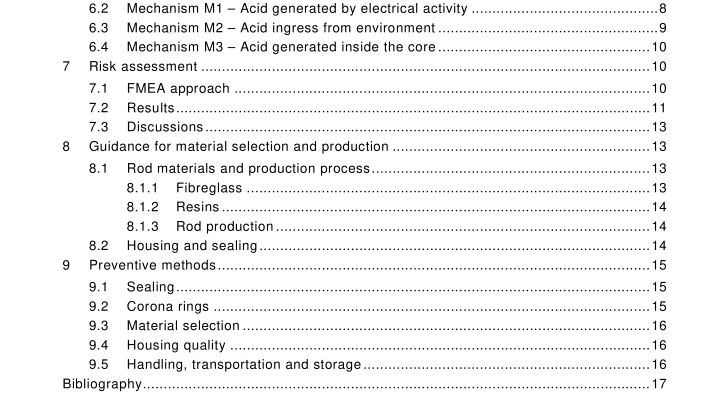IEC TR 62662:2010 pdf download – Guidance for production, testing and diagnostics of polymer insulators with respect to brittle fracture of core materials
6 Failure mechanisms
6.1 Description of identified failure mechanisms
For the time being, three failure mechanisms have been identified and are well described in recent literature [7], [8], and [9]. The final physical-chemical mechanism is stress corrosion cracking (SCC) which leads to “brittle fracture” of the FRP core. The initiation of SCC requires the presence of acid in direct contact with the FRP core material for all mechanisms. The way in which this acid appears on or inside the FRP core material can be differentiated into the following three mechanisms. NOTE Other mechanisms are currently under study, for example, crevice corrosion. The mechanisms are not yet sufficiently investigated to be included in this technical report. However, all require the presence of water (moisture).
6.2 Mechanism M1 – Acid generated by electrical activity
This mechanism is characterized by acid generation by internal and/or external electrical discharges with the acid being finally the root cause for stress corrosion of the FRP core material and the resulting brittle fracture of the FRP core. Acid (nitrogenous acids) is generated by electrical discharges (corona) on the insulating material (external), at the metal fittings (external) or by internal partial discharges within internal voids. Electrical discharges in air generate radicals, ozone and nitrogen oxides which form acids when combined with water (e.g. moisture from the air). Internal partial discharges within voids of the FRP core material or at the interface between FRP core and housing may lead to acid generation. In some cases moisture vapour transmission in a hot wet environment followed by a cold cycle will cause condensation inside voids. The acid is then in direct contact with the FRP core material. Moisture is required for all modes of this mechanism to generate acid. Therefore the penetration path to the FRP core is a very critical criterion for this mechanism. Moisture penetration may be possible if the sealing system is defective or insufficient. Other paths for moisture penetration to the FRP core may be housing damage or housing porosity. The moisture penetration can occur in the form of molecular diffusion due to the moisture permeability of the housing. Acids generated by electrical discharges are in general strong inorganic acids. The main chemical structures are HNO 2 and HNO 3 .
Polymeric compounds show in general a high resistance to HNO 3 and are often resistant to other acids. The same applies to the sealing systems at the end fitting (triple) point realized with such material compounds. Two main grades of FRP core materials exist:
• acid resistant core materials that pass the chemical resistance test in accordance with IEC 62039;
• non-acid resistant core materials that do not pass the chemical resistance test. Acid resistant rods can resist acid for a much longer time period than non-resistant materials (see Clause 8). The critical design features of composite insulators regarding this mechanism are:
• chemical (acid) resistance of the FRP core material;
• quality of the FRP core material regarding internal voids that may lead to internal partial discharges;
• quality of the macroscopic interface between housing and FRP core material regarding voids that may lead to internal partial discharges;
• long-term tightness of the sealing system;
• corona protection and field grading to reduce the appearance of acid-producing corona or partial discharges;
• resistance of the housing and sealing system regarding transportation and handling damage.
6.3 Mechanism M2 – Acid ingress from environment This mechanism is characterized by acid ingress from the environment (e.g. pollution) with the acid being finally the root cause for SCC of the FRP core material and the resulting brittle fracture of the FRP core.IEC TR 62662 pdf download.
